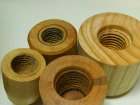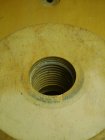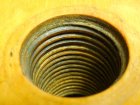I have some 9" wide, 1-3/4" thick LVL offcuts. I also have a Beall tap for my lathe spindle. I was thinking of tapping the LVL to make faceplates. Is there any reason this would be a bad idea? I've never tried to work LVL.
-
Beware of Counterfeit Woodturning Tools (click here for details) -
Johnathan Silwones is starting a new AAW chapter, Southern Alleghenies Woodturners, in Johnstown, PA. (click here for details) -
Congratulations to Keven Jesequel for "Big Leaf Maple" being selected as Turning of the Week for April 15, 2024 (click here for details) -
Welcome new registering member. Your username must be your real First and Last name (for example: John Doe). "Screen names" and "handles" are not allowed and your registration will be deleted if you don't use your real name. Also, do not use all caps nor all lower case.
You are using an out of date browser. It may not display this or other websites correctly.
You should upgrade or use an alternative browser.
You should upgrade or use an alternative browser.
LVL for faceplate?
- Thread starter Jason Matisheck
- Start date
I have some 9" wide, 1-3/4" thick LVL offcuts. I also have a Beall tap for my lathe spindle. I was thinking of tapping the LVL to make faceplates. Is there any reason this would be a bad idea? I've never tried to work LVL.
I don't know what LVL is, but I have successfully done what you are describing using Corian. It generally comes in 0.5 inch thickness and I laminate it with epoxy if I need something thicker.
Laminated Veneer Lumber? Isn't it basically really thick plywood (not OSB) in building lumber dimensions, ie 2x6, 2x8, 2x10? I've used glued up and tapped 3/4 inch ply with good results. I glue up about a 3 1/2 inch square, tap, thread it on the spindle and turn round, face off, cut a small mortice for the spindle shoulder, flip around, face off, then glue and screw this to the face plate board, then true the board round. Obviously wood face plates have limitations but some of the things I've made so far, are a bell for my vac chuck, a flat plate for the vac chuck, a 12" sanding disk and a few more things I can't remember...
Jason,
That is a good question to ask. At first glance, I would think the wooden face plate would be too week to handle the torsion imparted from applying a tool to the wood, especially if the cutting is interrupted (as it is multiple times / revolution when making things round). But that said, some face plates these days are made from aluminium, and that is also not as resilient as one made from steel.
People have used waste blocks made of wood which are secured to a piece with glue or even double sided tape. And that has less holding power than what I think you are proposing.
Seems like it should work.
Rich
That is a good question to ask. At first glance, I would think the wooden face plate would be too week to handle the torsion imparted from applying a tool to the wood, especially if the cutting is interrupted (as it is multiple times / revolution when making things round). But that said, some face plates these days are made from aluminium, and that is also not as resilient as one made from steel.
People have used waste blocks made of wood which are secured to a piece with glue or even double sided tape. And that has less holding power than what I think you are proposing.
Seems like it should work.
Rich
Here is one national manufacturer-
https://www.weyerhaeuser.com/woodproducts/engineered-lumber/microllam-lvl/
If, IF memory serves, even though LVL appears to be just "really thick plywood", plywood as a structural panel is built with ply grain orientation that alternates 90 degrees with each ply, to provide structural strength and stability to the panel in both the X and Y axis. LVL, if I recall, is built with ply grain in the same direction with each ply. It isn't designed to work like plywood for building sheathing for shear strength (mainly racking), LVL is designed to support vertical/gravity loads as beams, a stronger replacement for multi-ply 2x dimensional lumber beams. Thickness general starts at 1" (for rim/ribbon boards), and 1-3/4" is very common for multi-ply built up headers and beams.
Steve.
https://www.weyerhaeuser.com/woodproducts/engineered-lumber/microllam-lvl/
If, IF memory serves, even though LVL appears to be just "really thick plywood", plywood as a structural panel is built with ply grain orientation that alternates 90 degrees with each ply, to provide structural strength and stability to the panel in both the X and Y axis. LVL, if I recall, is built with ply grain in the same direction with each ply. It isn't designed to work like plywood for building sheathing for shear strength (mainly racking), LVL is designed to support vertical/gravity loads as beams, a stronger replacement for multi-ply 2x dimensional lumber beams. Thickness general starts at 1" (for rim/ribbon boards), and 1-3/4" is very common for multi-ply built up headers and beams.
Steve.
Last edited:
Steve, that is interesting. When tapping face grain solid wood, I get a little chipping on the short grain side. With the alternating grain of ply, I get better threads. Using a slightly larger drill bit than spec helps by leaving a flat on the thread peaks as does firming up with thin CA. I wonder if the adhesive in LVL would help prevent short grain chip out?
Boy, I don't know how the LVL plies would respond to tapping. Maybe tapping threads isn't needed, maybe initial screw insertion is enough to create a thread memory in the wood, unless you are using larger screws, like actual lag screws rather than smaller pan head wood or sheet metal screws. Pre-drill at a minimum, esp. for larger screws where you want to maintain a thread. Some plywood has plies that can run thick in the core layers, LVL seems to be quite uniform in thin layers. I would guess the adhesives and assembly pressures used for LVL is different than plywood. 4x8 sheets of plywood can take on a life of their own and distort in different directions, LVL stays quite uniform dimensionally and in plain.
Here's the website I should have included in my first reply, speaking to engineered lumber. About half way down is a quick explanation to LVL manufacturing, more research can be done at this site, too.
https://www.apawood.org/structural-composite-lumber
Here's the website I should have included in my first reply, speaking to engineered lumber. About half way down is a quick explanation to LVL manufacturing, more research can be done at this site, too.
https://www.apawood.org/structural-composite-lumber
Last edited:
I wood drill the lvl then pour in ultra thin ca glue. Then cut threads. I use lvl everyday at work building housed. It will work.I think the ca will toughen up the wood component of the lvl to hold threads better for a long period of time. Use tail stock support when you can.Boy, I don't know how the LVL plies would respond to tapping. Maybe tapping threads isn't needed, maybe initial screw insertion is enough to create a thread memory in the wood, unless you are using larger screws, like actual lag screws rather than smaller pan head wood or sheet metal screws. Pre-drill at a minimum, esp. for larger screws where you want to maintain a thread. Some plywood has plies that can run thick in the core layers, LVL seems to be quite uniform in thin layers. I would guess the adhesives and assembly pressures used for LVL is different than plywood. 4x8 sheets of plywood can take on a life of their own and distort in different directions, LVL stays quite uniform dimensionally and in plain.
Here's the website I should have included in my first reply, speaking to engineered lumber. About half way down is a quick explanation to LVL manufacturing, more research can be done at this site, too.
https://www.apawood.org/structural-composite-lumber
Personally I wouldn't use tapped any kind of wood for a faceplate. Faceplates are used because of rigidity, you won't get that with wood threads. LVLs I've dealt with don't have that smooth of a face, and may not even be dead flat.
Well, no clue actually. I would guess that some 'engineered' types of plywood could work. People do tap solid wood for waste blocks. I will never use plywood of any sort for a waste block as it will pull apart if you have any sort of catch. Personally, I would stick with metal.
robo hippy
robo hippy
So Jason, it seems the question is not really whether you can tap LVL with your Beal spindle tap (you can), but rather just what are you going to use these "faceplates" for???
To the OP Jason and Clifton, I guess I overlooked one very important detail- all along, for whatever reason, I was still thinking the LVL would be attached to a smaller faceplate as a wasteblock, the LVL increasing the diameter if the faceplate. Sorry for my oversight.
That said, I still have no idea how the LVL will hold a tapped thread to match the headstock spindle thread. Personally, like robo hippy, I'd stick to real steel for faceplates, but not for any reasons I can defend. $30-40 gets you several different metal faceplates at Rockler. Buy once, use for the rest of your life.
Steve.
That said, I still have no idea how the LVL will hold a tapped thread to match the headstock spindle thread. Personally, like robo hippy, I'd stick to real steel for faceplates, but not for any reasons I can defend. $30-40 gets you several different metal faceplates at Rockler. Buy once, use for the rest of your life.
Steve.
Last edited:
Can't argue with steel... Hopefully I won't have an anecdote to add to Emiliano's post on "Woodturning safety research", but if I do, it will be because I didn't listen to Clint Eastwood who said,
, well, that's what he would have said if he was a woodturner...Obviously wood face plates have limitations
So Jason, it seems the question is not really whether you can tap LVL with your Beal spindle tap (you can), but rather just what are you going to use these "faceplates" for???
Well... It's partly a case of "seems like I should be able to use this stuff for something." But my first two thoughts were: 1. Faceplate for holding half logs to rough out bowl exteriors. That's probably the dumber idea since I'm in the 12" - 24" range on bowls. 2. General purpose thing on which to mount friction drives for bowl interiors, and waste blocks.
A long time ago, I got a scrap of 2x12 equiv. LVL, 1-3/4" thick. I belt sanded 2 faces to remove any water resistant waxes and then glued them together. I cut as large of a bowl blank it allowed, and I made a bowl from it. What a pain in the butt. It sure has a different look, but that was the first and last time I'll do it, cutting was horrible. I think Baltic birch plywood would be preferable, but I've not used that, either, for turning.
Steve.
Steve.



